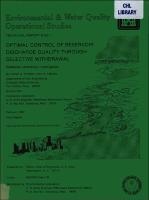Please use this identifier to cite or link to this item:
https://hdl.handle.net/11681/4535Full metadata record
| DC Field | Value | Language |
|---|---|---|
| dc.contributor | Colorado State University. Civil Engineering Department | - |
| dc.contributor | Hydraulics Laboratory (U.S.) | - |
| dc.contributor | Environmental and Water Quality Operational Studies (U.S.) | - |
| dc.contributor.author | Fontane, Darrell G. | - |
| dc.contributor.author | Labadie, John W. | - |
| dc.contributor.author | Loftis, Bruce | - |
| dc.date.accessioned | 2016-03-16T22:09:56Z | - |
| dc.date.available | 2016-03-16T22:09:56Z | - |
| dc.date.issued | 1982-02 | - |
| dc.identifier.uri | http://hdl.handle.net/11681/4535 | - |
| dc.description | Technical Report | - |
| dc.description | Abstract: This report presents a method combining simulation and optimization techniques to determine guidelines for operating selective withdrawal reservoir structures to meet downstream water temperature objectives. Optimal operation is achieved when operating rules that anticipate future critical temperature conditions are successfully applied. In this study, a one-dimensional reservoir thermal simulation model developed by the U. S. Army Engineer Waterways Experiment Station was used to simulate the thermal stratification cycle of a reservoir. The model was interfaced with a formulation called objective-space dynamic programming (OSDP) to develop the optimal operation strategy for each decision period. The OSDP formulation retains the integrity of the simulation model and minimizes an objective function related to deviations of predicted release temperature from downstream target temperature over a portion of the stratification cycle. Application to a case study shows the potential for using the dynamic programming technique, as compared to the normal period-by-period operation, to improve performance of the system. | - |
| dc.publisher | Environmental Laboratory (U.S.) | - |
| dc.publisher | Engineer Research and Development Center (U.S.) | - |
| dc.relation | http://acwc.sdp.sirsi.net/client/en_US/search/asset/1040364 | - |
| dc.rights | Approved for public release; distribution is unlimited. | - |
| dc.source | This Digital Resource was created from scans of the Print Resource | - |
| dc.subject | Dynamic programming | - |
| dc.subject | Optimization | - |
| dc.subject | Reservoirs | - |
| dc.subject | Selective withdrawal | - |
| dc.subject | Water quality | - |
| dc.subject | Computer simulation | - |
| dc.subject | Computer program | - |
| dc.title | Optimal control of reservoir discharge quality through selective withdrawal : hydraulic laboratory investigation | - |
| dc.type | Report | en_US |
| Appears in Collections: | Technical Report | |
Files in This Item:
| File | Description | Size | Format | |
|---|---|---|---|---|
| Technical Report E-82-1.pdf | 2.31 MB | Adobe PDF |  View/Open |